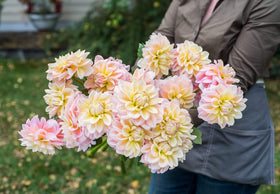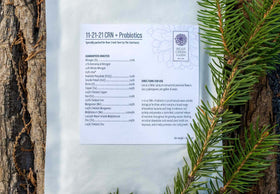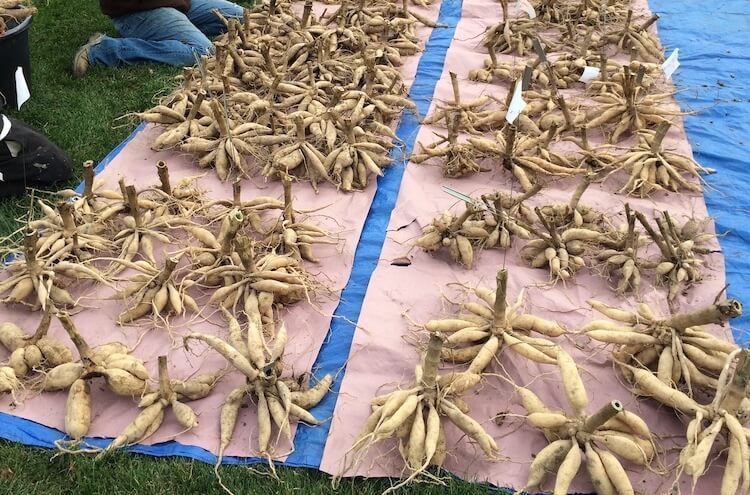A common specific question often posed to me concerns the difference between American grown Dahlia tubers and their Dutch tuber counterparts. In short, while there are differences in production, the splendid blooms between these tuber cousins, under the correct growing conditions, are, ultimately, similarly spectacular.
The differences between the two lie more in production and distribution than in the results of a specific bloom.
But let’s back up for a moment - let’s consider Dahlia tubers in general terms. (We were all novice growers once.) Dahlia tubers gestate in the ground over the course of months. As Spring softens the soil, in they go. As summer wanes and fall creeps in – when it seems as though colors everywhere are amplified, growers are launched into dahlia season. This season is replete with dahlias versatile in size and drenched in color. One of the special things about dahlia tubers is that, once the blooms are off the dahlias (or after first hard frost), the same tubers can be dug up, properly stored, and replanted for recurring stunning results – year after year. (In warmer climates, with a little care, tubers can remain in the ground.)
Dahlia tubers are easily misunderstood. They are gnarled, messy and time-consuming. They remind one of earthen clenched fists - waiting to be tended in exchange for the delivery of inestimable beauty. They are like caterpillars, evolving into butterflies, or frog princes waiting to be kissed.


The General Differences Between Dutch Dahlia Tubers and American Dahlia Tubers
- In short, Dutch dahlia tubers are grown from cuttings. These tubers are mowed and are dug up prior to any frost. (This is the primary reason that Dutch and American dahlia tubers are optically dissimilar - and it explains why the Dutch tuber variety will always be smaller, appearing to be more fragile.)
- Use of Parent Plants. In contrast, American Dahlia tubers are most often derived from parent Dahlia plants started from tubers.
- Sizes of Tubers. Although there is a difference in size, do not be deceived. Remember: it is only necessary that a viable eye is present on the tuber to produce a gorgeous bloom. (The eye of a dahlia tuber is a small area at the crown of the tuber, located at the base of the stem, and serves as the point at which growing will begin.)
- Product Shipped. Tubers from Holland are shipped as a full clump. Many of the "fingers" can sometimes be loose or hanging but this is not important if there is a viable eye in the crown. Tubers grown in the United States are generally shipped as single finger tubers. The clumps are pre-cut into individual fingers with eyes. It is easy to ship the Dutch tuber as a full clump because it is smaller and more lightweight than clumps grown in America. This is because cuttings yield a different, smaller clump than those from flowering plants grown from tubers.
For dahlia enthusiasts planning their garden and considering whether to invest in American or Dutch dahlia tubers, below are a few points to consider.

DUTCH DAHLIA TUBERS
- Implications of Export. Consider that Dutch dahlia tubers must be washed prior to import to protect against the inadvertent introduction of any pathogens (such as bacterium or pests) to American soil. Though American growers also wash tubers, it is not always necessary.
- Implications of Washing Dutch Tubers. Anytime water is introduced into this delicate operation, there is a greater possibility that something may go wrong. Given the scale of American growers, the vast majority was tubers by hand. However, at a production of fifty million Dutch tubers, most are machine washed and this is where variety mixups and other issues often occur.
-
Environment differential. Shipping between these tubers can be quite extensive because of international versus domestic shipping. However, beyond that, tubers from Holland are often shipped to Poland for washing and then back again, so there also an additional shipping step.

AMERICAN DAHLIA TUBERS
- Rendering Tubers from Parent Plants. Dahlia tubers produced in America are virtually always derived from parent plants directly, rather than from cuttings - they are single finger tubers rather than clumps, resembling carrot or fingers rather than a more gnarled (or closed) fist.
- Streamlined Procedures. American Dahlia tubers do not need to be washed prior to shipping though often are for esthetic reasons.
- Support for Slow Flower Movement. Most American dahlia tubers will originate from small farms, rather than from larger, often more industrial flower enterprises one is likely to find in Europe.
- Support Sustainability. American dahlia tubers tend to be produced as the result of more human hands-on labor. This is because smaller, slow flower farming does not, as a rule, integrate large machinery into their operations.
For more information about dahlia tubers, click here for our very own online tutorial, or contact us at info@bearcreekfarm.com. To be the first to know about occasional additional workshops about dahlia tubers (and more) follow us on Instagram.





Loved your post about American grown tubers.
could we use your sept. 27, 2022 article, " does country of origin matter for dahlia tubers" on our mid island dahlia society website? of course we would give you credit for thee report. tu, robert
Loved this post, very informative!